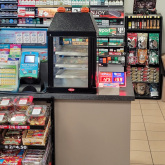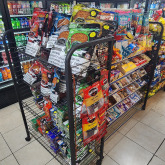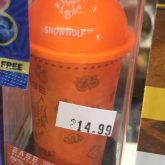Youth Targeting at the Point of Sale
Despite governmental efforts to protect youth from tobacco advertising, the tobacco industry continues to use tactics to appeal to youth. Research indicates that nearly all adult smokers first try cigarettes before age 18, so it’s no surprise that youth are an important target of the tobacco industry.
Evidence from industry documents
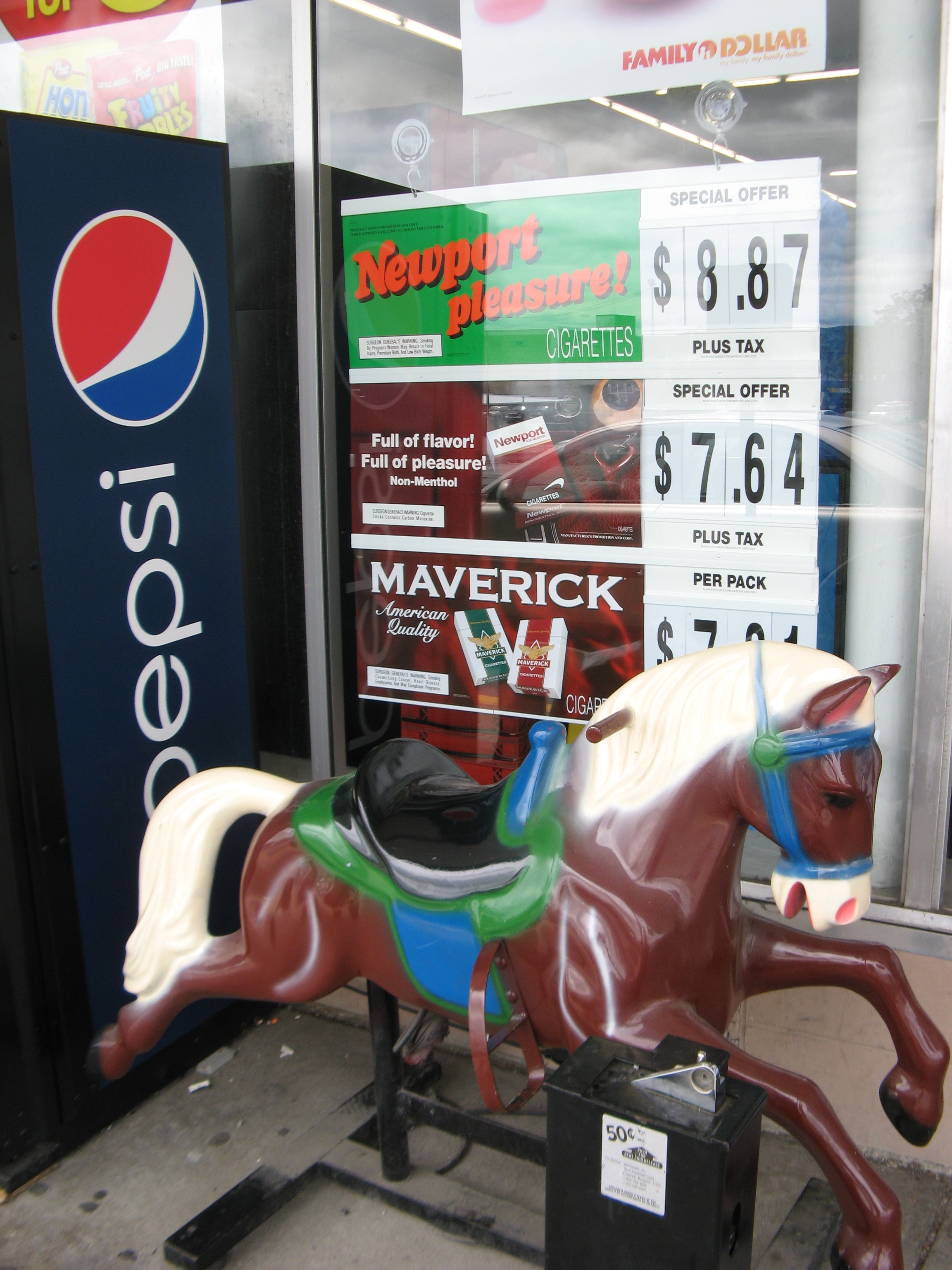 While tobacco companies used to create advertising campaigns directly for children, using whimsical packaging and cartoon characters, such direct messaging was eventually ruled illegal. In the 1998 Tobacco Master Settlement agreement, the companies agreed not to “take any action, directly or indirectly, to target youth within any state in the advertising, promotion or marketing of tobacco products.”
While tobacco companies used to create advertising campaigns directly for children, using whimsical packaging and cartoon characters, such direct messaging was eventually ruled illegal. In the 1998 Tobacco Master Settlement agreement, the companies agreed not to “take any action, directly or indirectly, to target youth within any state in the advertising, promotion or marketing of tobacco products.”
As a condition of the 1998 settlement, tobacco companies were required to make internal documents and memos public through a national database. The Legacy Tobacco Documents Library contains more than 13 million documents reaching back as far as the early 1900’s. Scholars and health professionals have analyzed these documents, finding evidence of tobacco executives specifically targeting youths.
“I have attached information on younger adult purchase patterns and target outlets for DB,” wrote one RJ Reynolds tobacco executive to another in 1984, about Project DB, a marketing effort targeting younger purchasers. The objective of a new marketing scheme would be “To offensively take share from Marlboro by capitalizing on the price sensitivity of younger adult smokers,” wrote another 1984 executive:

While the executives would argue that their discussion of “younger adults” was referring to those older than 18, there were instances where a broader interpretation was implied.
“The base of our business is the high school student,” wrote a tobacco executive regarding Newport cigarettes in 1978. An RJ Reynolds executive sent a memo in 1990 asking area sales representatives to identify areas near high schools or college campuses where tobacco sales were profitable and traffic was highest:

In 1990 RJ Reynolds came under criticism after the Wall Street Journal published a story about a supervisor who attempted to market cigarettes specifically to schoolchildren. In the memo obtained by the Journal, the supervisor, James McMahon, instructed a regional sales manager, Terrance Sullivan, to implement the program in stores:
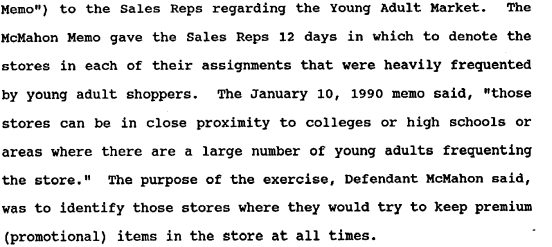
Sullivan refused to sign off on the program, and later sued RJ Reynolds when he was fired for doing so.
The examples of executives targeting youths are numerous. In a 1998 RJ Reynolds memo titled, “The Importance of Younger Adults,” an executive outlined the need to retain young smokers. “Younger adults are the only source of replacement smokers,” he wrote. “Today’s younger adult smoking behavior will largely determine the trend of Industry volume over the next several decades. If younger adults turn away from smoking, the Industry must decline, just as a population which does not give birth will eventually dwindle.”
Tactics to target youth at the point of sale
Pricing
Tobacco companies know that youth use of tobacco is price-sensitive and that raising tobacco prices reduces youth smoking. Lower prices encourage youth to initiate tobacco use and, along with coupons and other price discounts, encourage youth to move from experimentation to regular smoking.[1] A study of New York State retailers found that retailers located in neighborhoods with a higher proportion of youth residents were more likely to offer price promotion on menthol cigarettes, which have been linked to youth tobacco use initiation, than retailers located in neighborhoods with a lower proportion of youth residents. [2, 3] In 2012, 30% of youth reported recent exposure to coupons for tobacco, and exposure was associated with greater intentions to purchase cigarettes, higher susceptibility to smoking among never smokers, and lower confidence in quitting among current smokers.[4]
I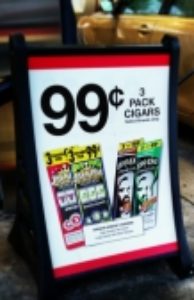 n addition, selling products like cigarillos, little cigars, or blunts as singles or in small pack sizes allows price-sensitive consumers, like youth, to continue to purchase tobacco despite limited budgets. In a survey of tobacco retailers in Dayton and Cleveland, Ohio (two cities in “Tobacco Nation“), nearly 70% of stores sold single cigarillos, little cigars, or blunts, with 87% of them advertising the products for less than $1, an accessible price point for cash-strapped youth. Strategies like setting minimum pack sizes and minimum pricing laws can help address these extremely low price points.
n addition, selling products like cigarillos, little cigars, or blunts as singles or in small pack sizes allows price-sensitive consumers, like youth, to continue to purchase tobacco despite limited budgets. In a survey of tobacco retailers in Dayton and Cleveland, Ohio (two cities in “Tobacco Nation“), nearly 70% of stores sold single cigarillos, little cigars, or blunts, with 87% of them advertising the products for less than $1, an accessible price point for cash-strapped youth. Strategies like setting minimum pack sizes and minimum pricing laws can help address these extremely low price points.
Flavors
Studies show that flavors play a major role in youth initiation and use of tobacco products. At least two-thirds of youth tobacco users report using tobacco products “because they come in flavors I like.”[5] Over 80% of youth who have ever used tobacco started with a flavored product,[6] and longitudinal data has shown that youth and young adults whose first use of tobacco was with a flavored product were more likely to subsequently use tobacco products.[7]
Tobacco industry documents archived through the UCSF Industry Documents Digital Library show that tobacco companies strategically used sweet, fruity, candy-like flavors to market their products to youth:

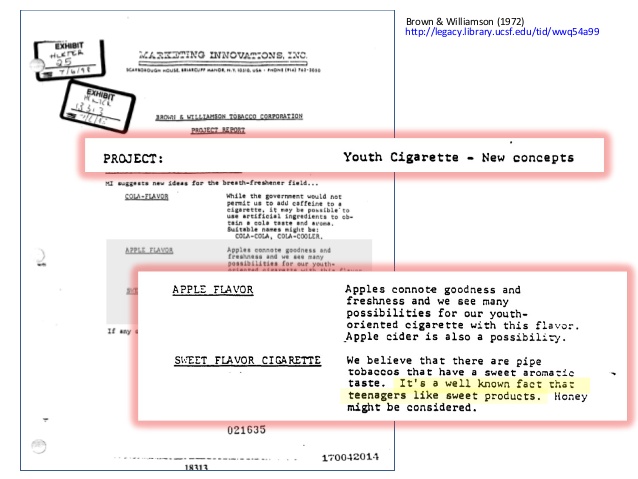
Although characterizing flavors (with the exception of tobacco and menthol) in cigarettes have been banned since 2009, other flavored tobacco products have remained on the market and become much more prevalent in the years since. These products include flavored smokeless tobacco, cigars and cigarillos, e-cigarettes, hookah, and modern oral nicotine products, and are sold in an array of flavors that range from fruit flavors to candy or confectionery flavors, to alcoholic beverage to herbs and spices.
In January 2020, the FDA issued guidance restricting some flavors in cartridge-based e-cigarettes, but exempted menthol-flavored e-cigarettes and did not include flavored e-liquids or disposable e-cigarettes. As a result, sales of many of these exempted products have grown substantially with youth shifting to the flavors and flavored products that remain on the market.
In April 2021, FDA announced its plans to propose tobacco product standards within the next year to ban menthol as a characterizing flavor in cigarettes and ban all characterizing flavors (including menthol) in cigars. However, this rule will likely take years to finalize and implement and would still leave many dangerous flavored tobacco products that appeal to youth on the market.
Product placement and advertising
Exposure to tobacco advertisements, which blanket retail stores, has been shown to increase initiation and continuation of tobacco use, especially among youth. The National Cancer Institute has demonstrated a causal relationship between exposure to tobacco advertisements and youth smoking uptake. Across multiple studies, research has shown that youth more frequently exposed to tobacco promotion are 60% more likely to have tried smoking and 30% more likely to be susceptible to future smoking.[8] In addition, exposure to tobacco marketing at the point of sale fosters positive brand imagery[9] and distorts youth perceptions about the availability, use, and popularity of tobacco products.[10, 11]
Since we know at least 44% of teens in the US attend school within 1000ft of a tobacco retailer, [12] and 77% of public schools are within a 10-minute walk of a tobacco retailer, [13] it’s especially important to address how tobacco is advertised to youth at the point-of-sale. Learn more about banning tobacco sales or POS advertising near schools in our Stores Near Schools Evidence Summary.
Tobacco companies also use colorful packaging, sometimes imitating packaging of popular candy brands, to catch the attention of youth.

On top of this, the retail environment often features tobacco product advertisements at children’s eye level (less than 3 ft off the ground) and products placed near candy, toys, or other youth friendly products. Currently, only cigarettes and smokeless products are prohibited from self-service displays, which increase accessibility of tobacco products to youth.[14] Product placement restrictions are an option to help to control the visibility and accessibility of tobacco products to youth.
Images of Tobacco Marketing with Youth Appeal at the Point of Sale from our Media Gallery
Resources
- CounterTobacco.org Youth and Community Engagement Activities
- Counter Tobacco Podcast: Tobacco’s Replacement Smokers
- Stories From the Field: Youth Engagement in Point-of-Sale Tobacco Control
- Campaign for Tobacco Free Kids:
- Tobacco Company Marketing to Kids
- In Their Own Words: What Cigar Companies, Retailers, And Analysts Say About Cheap And Kid-Friendly Products
- Smokeless Tobacco and Kids
- The Flavor Trap: How Tobacco Companies Are Luring Kids With Candy-Flavored E-Cigarettes and Cigars
- E-Cigarettes: Flavored Products Fuel a Youth Epidemic
- Youth Access and Exposure to E-Cigarettes at the Point of Sale
- Flavored Tobacco Products Attract Kids
- Youth Engagement Alliance for Tobacco Control
- Truth Initiative’s Community and Youth Engagement


